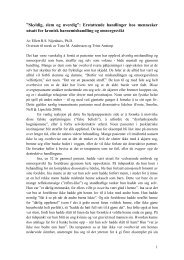rapport 2015:4
641aa6d88d
641aa6d88d
You also want an ePaper? Increase the reach of your titles
YUMPU automatically turns print PDFs into web optimized ePapers that Google loves.
23. Lamb, M.E., et al. (2007). A structured forensic<br />
interview protocol improves the quality and<br />
informativeness of investigative interviews with<br />
children: A review of research using the NICHD<br />
Investigative Interview Protocol. Child Abuse &<br />
Neglect. 31(11): p. 1201-1231.<br />
24. Sjoberg, R.L. and T. Lindholm (2009). Children’s<br />
autobiographical reports about sexual abuse: A<br />
narrative review of the research literature. Nordic<br />
Journal of Psychiatry. 63(6): p. 435-442.<br />
25. Brubacher, S.P., M.B. Powell, and K.P. Roberts<br />
(2014). Recommendations for interviewing children<br />
about repeated experiences. Psychology, Public<br />
Policy, and Law. 20(3): p. 325-335.<br />
26. Roberts, K.P. and M.B. Powell (2001). Describing<br />
individual incidents of sexual abuse: a review<br />
of research on the effects of multiple sources of<br />
information on children’s reports. Child Abuse &<br />
Neglect. 25(12): p. 1643-59.<br />
27. Lyon, T.D., E.C. Ahern, and N. Scurich (2012). Interviewing<br />
children versus tossing coins: Accurately<br />
assessing the diagnosticity of children’s disclosures<br />
of abuse. Journal of Child Sexual Abuse. 21(1): p.<br />
19-44.<br />
28. Ceci, S. and R. Friedman (2000). The suggestibility<br />
of children: Scientific research and legal implications’.<br />
Cornell Law Review. 86: p. 33 at 101.<br />
29. Lyon, T.D. (2014). Interviewing children. Annual<br />
Review of Law and Social Science. 10: p. 73-89.<br />
30. Elbers, E. (2004). Conversational asymmetry and<br />
the child’s perspective in developmental and educational<br />
research. International Journal of Disability,<br />
Development and Education. 51(2): p. 201-215.<br />
31. Docherty, S. and M. Sandelowski (1999). Focus<br />
on qualitative methods - Interviewing children.<br />
Research in Nursing & Health. 22(2): p. 177-185.<br />
32. Solberg, A. (2014). Reflections on interviewing<br />
children living in difficult circumstances: courage,<br />
caution and co-production. International Journal<br />
of Social Research Methodology. 17(3): p.<br />
233-248.<br />
33. Kortesluoma, R.L., M. Hentinen, and M. Nikkonen<br />
(2003). Conducting a qualitative child interview:<br />
methodological considerations. Journal of<br />
Advanced Nursing. 42(5): p. 434-441.<br />
34. Bondevik, M. and I.S. Meren (1997). Terapeuters<br />
møte med barn og foreldre i konfliktfylte situasjoner.<br />
Hovedoppgave psykologi. Universitetet i<br />
Oslo.<br />
35. Brackenbury, L., D. Barzman, and N. Dunsleth<br />
(2009). Evaluating forensic interviewing of children<br />
in sexual abuse cases: Guidelines for the forensic<br />
psychiatrist. American Journal of Forensic<br />
Psychiatry. 30(2): p. 45-61.<br />
36. Eisen, M.L. and G.S. Goodman (1998). Trauma,<br />
memory, and suggestibility in children. Development<br />
and Psychopathology. 10(4): p. 717-738.<br />
37. Langballe, A. (2007). The relationship between<br />
children’s free, spontaneous narratives presented<br />
to the court and the reliability of these statements.<br />
Tidsskrift for Norsk Psykologforening. 44(7): p.<br />
868-877.<br />
38. Reyna, V.F., R. Holliday, and T. Marche (2002).<br />
Explaining the development of false memories.<br />
Developmental Review. 22(3): p. 436-489.<br />
39. Warren, A.R. and L.S. McGough (1996). Research<br />
on children’s suggestibility implications for the<br />
investigative interview. Criminal Justice and Behavior.<br />
23(2): p. 269-303.<br />
40. Ceci, S.J. and M. Bruck (1995). Jeopardy in the<br />
courtroom: A scientific analysis of children’s testimony.<br />
Washington, DC: American Psychological<br />
Association.<br />
41. Garber, B.D. (2007). Developing a structured interview<br />
tool for children embroiled in family litigation<br />
and forensic mental health services: The Query Grid.<br />
Journal of Forensic Psychology Practice. 7(1): p.<br />
1-18.<br />
42. Lampinen, J.M., J.S. Neuschatz, and D.G. Payne<br />
(1998). Memory illusions and consciousness: Examining<br />
the phenomenology of true and false memories.<br />
Current Psychology. 16(3-4): p. 181-224.<br />
Rapport <strong>2015</strong>:4 • Folkehelseinstituttet 93



